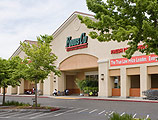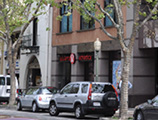My recent observation that San Francisco’s office market has lost 60 percent of its value may have been optimistic. In the last month, a quality high-rise at 350 California Street has apparently gone into escrow at a price 75 percent less than its 2020 value. If it closes at its reported $67 million sale price, the tower will have sold for $225 a foot.
And if $225 is the office market’s new price-per-pound, tens of billions have been lost, scores of owners will likely be foreclosed upon and as many lenders will take staggering write-downs on their loan portfolios. But—hold it, here’s the entrepreneurial spin—as many opportunities will arise from the ruins. While no blood is running, the financial district’s streets are so awash in red ink that it may not be fools rushing in to buy. A first-rate tower snapped up at $225 a foot can compete on rent with any high-rise in the country.
Yet buying today requires a boatload of cash, which for the moment is more elusive than the ivory-billed woodpecker. The Greek choruses from two major commercial real estate conferences in May—the ULI in Toronto and the ICSC in Las Vegas—were singing from the same hymnal: banks are only lending to those who truly don’t need the money (i.e., your credit is better than theirs) and big-time equity is sitting on its hands, sure the economy will worsen and deals sweeten in the coming months. The 350 California buyer reportedly bridged this gap by bringing in an all-cash investor from Korea. As an aside, it often seems that locals—battered by fortune’s slings and arrows—fail to see the obvious, that which is so apparent from afar: in this instance, that San Francisco is still arguably the loveliest city in America, that tourism and tech will rebound, that its benign weather will only become more attractive as the climate warms, and that the Bay Area’s world-class universities will doubtless continue to birth billionaires and their salutary trickle-down effects. While it takes years, devastating fires trigger the rebirth of overgrown, choked-out forests. An order of magnitude reset of San Francisco values could have that same long-term regenerative effect. When the office workers return—most eventually will—those who bought at today’s prices could be lauded as savants.
But is $225 a foot truly the bottom? It feels close, but the city does have 36 million square feet of empty office space. Even when workers do return, it could be that millions of square feet will go begging, that dozens of office buildings will never again be occupied. What to do?
New York City faced the same issue in lower Manhattan in the early nineties: a raging real estate recession, skyrocketing vacancy rates and no faith in the future of office demand. As it happened, a major component of NYC’s solution was the conversion of nearly 13 million feet of office space into 12,865 dwelling units, a conversion made economically feasible by tax credits issued by the Giuliani administration to office building owners. (See “The Potential for Office-to-Residential Conversions. Citizens Budget Commission”. Citizens Budget Commission 421-G report)
I asked a handful of contractors and building owners whether conversions to residential could help save our financial district. With one major exception, none thought so, citing the paucity of truly suitable candidates (older buildings with small, narrow floor plates and windows on all four sides), the potentially disastrous unknowns inherent in renovating as opposed to building ground-up and the questionable economics of building apartments today.
Oz Erickson, founder and CEO of the Emerald Fund was the outlier. Having done it already—his team successfully converted 100 Van Ness, a forlorn 28 story high-rise into 418 apartments in 2015—he is certain it can be done again today, and insists that a mass conversion of office to residential, as much as 10 million feet, is a “matter of life or death” to the city.
The catch—there’s always a catch—is the numbers. According to Oz, the only chance for residential conversions lies in a massive rewrite of the city’s development playbook. For a conversion to pencil out, Oz says the city must: 1) waive all of its own fees and charges for new dwellings (about $200,000 a unit); 2) make swift conversions a matter of right, thereby eliminating the endless planning purgatory for which San Francisco is justly famous; 3) waive property tax increases for fourteen years after the building’s reopening; and 4) perhaps most importantly, revise design and seismic standards to reflect the limitations of working within existing buildings.
Given San Francisco’s political reality, the threshold question is not whether Oz’s projections will actually work, but whether what would doubtless be viewed as a massive bailout of the moneyed class has the slightest chance of passage. Until the city rids itself of the politicians who personally hastened business’s exodus and replaces them with our next Willie Brown, I fear our office towers will stand as empty testaments to folly.






















